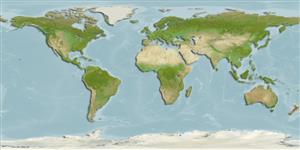Actinopterygii (ray-finned fishes) >
Gobiesociformes (Clingfishes) >
Gobiesocidae (Clingfishes and singleslits) > Gobiesocinae
Etymology: Haplocylix: Greek, haploos = single + Greek, kylix, -ikos = glass, cup (Ref. 45335).
Environment / Climate / Range
Ecology
Marine; demersal; depth range 0 - 12 m (Ref. 9003). Temperate, preferred ?
Southwest Pacific: endemic to New Zealand.
Size / Weight / Age
Maturity: Lm ? range ? - ? cm
Max length : 15.0 cm TL male/unsexed; (Ref. 9003); max. reported age: 6 years (Ref. 9003)
Short description
Morphology | Morphometrics
Dorsal
spines
(total): 0;
Dorsal
soft rays
(total): 5-6;
Anal
spines: 0;
Anal
soft rays: 8 - 9. Color ranging from uniform olive green to golden brown or yellowish, sometimes lighter ventrally. Sometimes with darker streaks over the head and body or patches of white or pink. Distinguished from other clingfishes by its large size, broad spade-like body, and structure of sucking disc (absence of a fold of skin on the anterior margin of the rear portion).
Common in rock pools, larger individuals found in subtidal area. Usually attached to seaweeds (Cystophora, Macrocystis and Lessonia), sometimes on rocks and boulder in areas with dense seaweed. Remains motionless when the pool is disturbed.
Paulin, C. and C. Roberts, 1992. The rockpool fishes of New Zealand (Te ika aaria o Aotearoa). Museum of New Zealand (Te Papa Tongarewa). 177 p. (Ref. 9003)
IUCN Red List Status (Ref. 115185)
CITES (Ref. 94142)
Not Evaluated
Threat to humans
Harmless
Human uses
More information
Age/SizeGrowthLength-weightLength-lengthLength-frequenciesMorphometricsMorphologyLarvaeLarval dynamicsRecruitmentAbundance
ReferencesAquacultureAquaculture profileStrainsGeneticsAllele frequenciesHeritabilityDiseasesProcessingMass conversion
Tools
Special reports
Download XML
Internet sources
Estimates of some properties based on models
Phylogenetic diversity index (Ref.
82805): PD
50 = 1.0000 [Uniqueness, from 0.5 = low to 2.0 = high].
Bayesian length-weight: a=0.00537 (0.00277 - 0.01043), b=3.11 (2.93 - 3.29), in cm Total Length, based on LWR estimates for this species & (Sub)family-body (Ref.
93245).
Trophic Level (Ref.
69278): 3.4 ±0.3 se; Based on size and trophs of closest relatives
Resilience (Ref.
69278): Low, minimum population doubling time 4.5 - 14 years (Fec = 50).
Vulnerability (Ref.
59153): Moderate vulnerability (43 of 100) .
